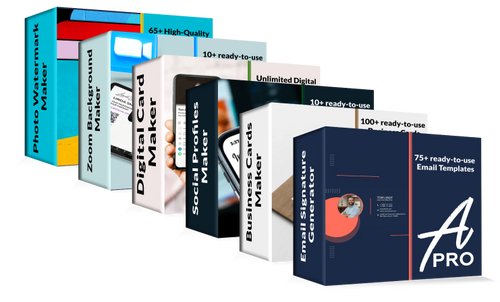A business card's effectiveness in this digital age cannot be overstated. As a freelancer, small business owner, or entrepreneur, it's critical to make a strong first impression on potential clients and partners. We'll show you how to produce your own business cards from scratch in this extensive tutorial, beginning with the design phase and ending with printing options. Prepare to advertise your firm and make an impression by following our step-by-step instructions for producing business cards.
How To Make Business Cards
Step 1: Determine your branding
Before you start designing your business cards, it's important to have a clear understanding of your branding. This includes your logo, colors, fonts, and overall aesthetic. Make sure your business cards align with your brand identity to create a cohesive and professional look.
Step 2: Choose the right design software
There are many design software options available, both free and paid, that can help you create your business cards. Some popular choices include Adobe Illustrator, Canva, and Microsoft Word. Choose a software that you are comfortable with and that provides the necessary design tools for your project.
Step 3: Select the size and shape of your business cards
Business cards come in various sizes and shapes. The standard size is 3.5 inches by 2 inches, but you can also opt for square cards or custom sizes. Consider your branding and what will make your business cards stand out from the rest. Keep in mind that unconventional sizes may be more expensive to print.
Step 4: Design the layout
When it comes to the layout of your business cards, simplicity is key. Make sure the important information, such as your name, job title, contact details, and company logo, are easily readable. Avoid cluttering the card with too much text or images. Use white space effectively to create a clean and professional look.
Step 5: Choose the right fonts and colors
Select fonts and colors that align with your brand and are easy to read. Fonts should be legible and not overly decorative. Stick to a maximum of two or three fonts to maintain a cohesive look. As for colors, choose a palette that matches your branding and creates a visually appealing contrast. Remember to consider readability when selecting font and background colors.
Step 6: Include essential information
Your business cards should include essential information that potential clients and partners need to contact you. This includes your name, job title, phone number, email address, and website. You can also include your social media handles if relevant to your business. Make sure the information is accurate and up to date.
Step 7: Add your logo and visuals
Your logo is an important visual element that represents your brand. Make sure to include it on your business cards in a prominent and visually appealing way. You can also add other visuals, such as icons or patterns, that align with your brand and enhance the overall design.
Step 8: Proofread and finalize your design
Before sending your design for printing, thoroughly proofread all the text on your business cards. Check for any spelling or grammatical errors, as well as ensuring that all the information is accurate. Once you are confident in your design, save it in a print-ready format and double-check the specifications required by your chosen printing service.
Step 9: Choose the right printing options
When it comes to printing your business cards, there are several options to consider. Offset printing is a popular choice for high-quality and large-quantity orders, while digital printing is more cost-effective for smaller quantities. Consider the paper type, finish, and size that best suit your business and brand. It's also important to review the printing service's guidelines and requirements to ensure your design is compatible.
Step 10: Distribute your business cards strategically
Once your business cards are printed and ready to go, it's time to distribute them strategically. Carry a stack with you wherever you go, whether it's to networking events, conferences, or meetings. Leave a few at local businesses that allow for flyer or card exchanges. You can also include them in mailouts or promotional packages. Don't be shy about handing them out and sharing your contact information with potential clients or partners.
How Can I Create a Unique Business Card?
Creating a unique business card is essential for standing out in a sea of competition. One way to achieve this is by utilizing the Artlogo's online business card templates and their user-friendly business card maker. With a wide range of professionally designed templates to choose from, Artlogo offers a variety of styles and themes to suit any industry or personal brand. Their business card maker allows you to customize the templates with your own text, color scheme, and images, ensuring that your business card reflects your unique identity. Explore the Artlogo custom business cards with one of a kind templates guranteed to make a lasting impression on potential clients and partners.
How Can I Print My Business Cards At Home?
- Design your business card: Use a design software or an online template to create your business card. Make sure to include your logo, contact information, and any other relevant details.
- Choose the right paper: Select a high-quality cardstock paper that is compatible with your printer. Look for a heavier weight paper (around 250gsm) to ensure durability and a professional look.
- Set up your printer: Adjust your printer settings to match the dimensions of your business card. You can typically find these settings in the print dialog box or printer preferences. Make sure to select the appropriate paper type and quality settings.
- Print a test page: Before printing the entire batch, it's a good idea to print a test page to check the alignment, colors, and overall appearance. Make any necessary adjustments before proceeding.
- Print your business cards: Load the cardstock paper into your printer's paper tray. Print one sheet at a time to ensure accuracy and avoid paper jams. Allow the ink to dry completely before handling the cards.
- Cut the cards: Use a paper cutter or a sharp pair of scissors to carefully cut along the printed guidelines. Take your time to ensure clean and straight edges.
- Final touches: Once your business cards are cut, you can add any finishing touches like rounded corners or a glossy finish using a laminator or specialized tools.
What Is The Best Font To Use On a Business Card?
The most important aspect of any font is its readability. You want to ensure that the text on your business card is clear and easy to read, even at small sizes. Avoid overly decorative or intricate fonts that may be difficult to decipher.
Helvetica
Helvetica is a widely-used sans-serif font that is known for its clean and modern look. It is highly readable, making it a popular choice for business cards across various industries.
Arial
Arial is another sans-serif font that is similar to Helvetica but slightly more rounded. It is also highly readable and works well for business cards.
Times New Roman
Times New Roman is a classic serif font that has a more traditional and elegant feel. It is often used in industries such as law or finance, where a sense of tradition and credibility is important.
Calibri
Calibri is a simple and modern sans-serif font that looks well on business cards. It has recently become a popular option.
Futura
Futura, a geometric sans-serif font, is a great choice for a contemporary design. It's common in fields like technology and design, where originality and foresight are valued.
Your business card should be a reflection of your brand, so it's important to choose a font that is consistent with your overall branding. If you already have a brand font, consider using it on your business card to maintain consistency and reinforce your brand identity.
Conclusion
Creating your own business cards can be a rewarding and cost-effective way to showcase your brand and make a lasting impression. By following the step-by-step guide outlined in this article, you can design and print unique business cards that reflect your professionalism and expertise. Whether you choose to utilize online templates or invest in a business card maker, the options are endless. Remember to select high-quality materials, pay attention to design details, and take the time to print and cut your cards with precision. With your personalized business cards in hand, you'll be ready to confidently network and leave a lasting impact on potential clients and partners.
Final Thoughts
Take your brand to new heights with Artlogo's expertise in crafting elegant handwritten signatures, logos, and business cards. Whether you're an independent freelancer, a small business owner, or a member of a large corporate team, our personalized approach ensures a memorable impression wherever you go. Unleash your creativity with our collection of free digital business card templates and experience the Artlogo advantage today.
Sources
























Share to: